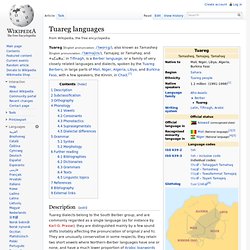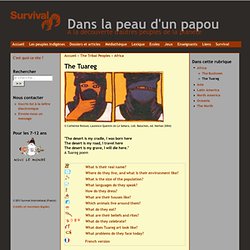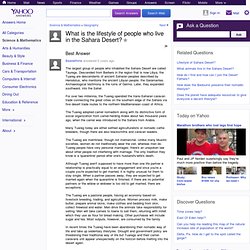

Life in the Sarah. Tuareg: 5 Things you need to know about the Tuareg people of North Africa. Please support our site by enabling javascript to view ads.

Tuareg languages. Tuareg (English pronunciation: /ˈtwɑrɛɡ/), also known as Tamasheq (English pronunciation: /ˈtæməʃɛk/), Tamajaq, or Tamahaq, and ⵜⴰⵎⴰⵌⴰⵆ in Tifinagh, is a Berber language, or a family of very closely related languages and dialects, spoken by the Tuareg Berbers, in large parts of Mali, Niger, Algeria, Libya, and Burkina Faso, with a few speakers, the Kinnin, in Chad.[7] Description[edit] Tuareg dialects belong to the South Berber group, and are commonly regarded as a single language (as for instance by Karl-G.

Prasse); they are distinguished mainly by a few sound shifts (notably affecting the pronunciation of original z and h). They are unusually conservative in some respects; they retain two short vowels where Northern-Berber languages have one or none, and have a much lower proportion of Arabic loanwords than most Berber languages. Subclassification[edit] Blench (ms, 2006) lists the following as separate languages, with dialects in parentheses:[9] Orthography[edit] Phonology[edit] TUAREG. 1.

Abstract Desertification, defined by the UN as “the degradation of land in arid, semi-arid, and dry sub-humid areas,” is a contentious issue. Some scientists deny that the cause is attributable to human actions (such as overgrazing and firewood gathering), arguing that it is caused by climatic change that does not relate to local human activities. This paper will explore the causes of desertification, as well as the social and economic impact on people living in regions that are “desertifying.” The conflicts in Mali and Niger during the 1990s involving the Tuareg will serve as a case study of these social and economic impacts. 2.
The Tuareg are a mainly nomadic people who live in the semi-arid Sahel and arid Sahara in an area that overlaps with the modern nations of Mali, Niger, Nigeria, Burkina Faso, Algeria and Libya. Tuareg society is composed of a multitude of individual tribes with different languages and varying customs depending on location. 3. The Tuareg. © Catherine Reisser, Laurence Quentin (in Le Sahara, coll.

Baluchon, ed. Nathan 2004) "The desert is my cradle, I was born here The desert is my road, I travel here The desert is my grave, I will die here. " A Tuareg poem What is their real name? The Tuareg are Berbers, a tribal people who have lived in North Africa since prehistoric times. Where do they live, and what is their environment like? The Tuareg live in the Saharan desert, where temperatures can reach 50° C during summer and drop to 0° C during the winter nights. The Tuareg are nomads who have always travelled with their caravans over a huge region that the French started dividing up with borders in 1905. What is the lifestyle of people who live in the Sahara Desert. The largest group of people who inhabited the Sahara Desert are called Tauregs.

Descended from Berbers in the region that is now Libya, the Tuareg are descendants of ancient Saharan peoples described by Herodotus, who mentions the ancient Libyan people, the Garamantes. Archaeological testimony is the ruins of Germa. Later, they expanded southward, into the Sahel. For over two millennia, the Tuareg operated the trans-Saharan caravan trade connecting the great cities on the southern edge of the Sahara via five desert trade routes to the northern Mediterranean coast of Africa.
The Tuareg adopted camel nomadism along with its distinctive form of social organization from camel-herding Arabs about two thousand years ago, when the camel was introduced to the Sahara from Arabia. Many Tuareg today are either settled agriculturalists or nomadic cattle breeders, though there are also blacksmiths and caravan leaders. Nomads of the Sahara Desert - English blog. Features.

The Sahara's Tuareg. Staff writer Peter Gwin received a grant to research the Tuareg from the Pulitzer Center on Crisis Reporting as part of its Untold Stories series.

The rebel commander, his face hidden behind a dark turban, leads the way over the soft sand, scorched black in places by exploded mortar shells and littered with detritus from a series of battles waged here, on a children's soccer field. With nearly every stride, our feet crunch spent rifle cartridges. "Step in my steps," he cautions, noting that the Niger army had mined the area, where there had been a school for Tuareg. His men removed some of the devices; others remained lost in the shifting sands. "Maybe they are buried too deep to explode if you step on one. " It is late afternoon in the dry season, and the temperature has finally slipped below 100°F. "My father only knew how to live in the desert," the commander says.
It is growing late, and the rebels are edgy about lingering in this exposed position. The tuareg tribe information in the sahara desert. Encyclopedia.com articles about Tuareg. The Sahara Desert: Hot Sands of Africa. The Sahara Desert is one of the world's most recognizable places.

It is also one of the harshest places to live. The desert stretches 3,000 miles across the northern part of Africa. More than one-quarter of its surface is sand dunes, some as high as 500 feet. Fun Desert Facts for Kids - Interesting Information about the Sahara & more.